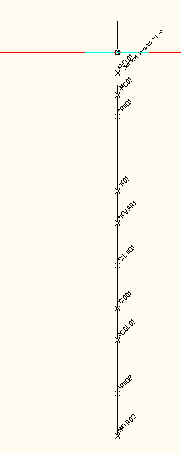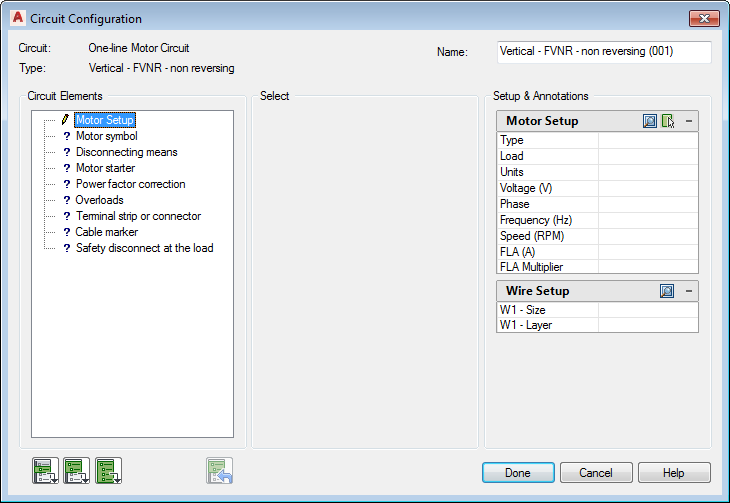Use Circuit Builder to insert a one-line motor circuit and size the wires based on industry standards.
- In the Project Manager, Project Drawing List, double-click
One-Line.dwg.
One-Line.dwg contains a one-line bus. This wire is drawn on a wire layer defined as No Wire Numbering. Such a wire layer behaves normally for inserting, breaking, and scooting components. These wires also show up in the from/to report. Wire numbers are not placed on these wires during the Insert Wire Numbers process.
Insert the one-line circuit
-
Click


 . Find
. Find
The Circuit Selection dialog box displays.
- Expand One-line Motor Circuit.
- Select Vertical - FVNR - non reversing.
- Click Configure.
- Specify an insertion point on the one-line bus.

The Circuit Configuration dialog box displays.
- In the Circuit Elements section, select
Motor Setup.

-
 In the Setup & Annotations: Motor Setup section, select the Browse button.
In the Setup & Annotations: Motor Setup section, select the Browse button.
The Motor Table Not Found dialog box displays. The sample project is set up to use the NEC standard. However, a MOTOR_NEC table is not supplied, only a default MOTOR table.
- Select Use default table.
The Select Motor dialog box displays.
- Select Type: Induction, Voltage (V): 480, and Frequency (HZ): 60.
- Select the row that shows Load:
15, Units:
HP, Phase:
3, Speed (RPM):
3600, FLA (A)
18.6.
Note: The values used to populate this dialog box are defined in the MOTOR* tables in the electrical standards database file, ace_electrical_standards.mdb.
- Click OK.
The values are entered in the Motor Setup section. A default wire size, based on the load for the motor, is selected and shown in the Wire Setup section.
-
 In the Setup & Annotations: Wire Setup section, select the Browse button.
In the Setup & Annotations: Wire Setup section, select the Browse button.
The Wire Size Lookup dialog box displays. The minimum wire size is preselected. The size is based on the load for the selected motor.
Note: When Show all is on, wires where the %Ampacity value is greater than 100% and less than 300%, are shown in red.The values in the Load section are populated with the values from the Motor Setup. The options available within this dialog box are defined in the electrical standards database file, ace_electrical_standards.mdb.
- In the Wire section, select Size standard: AWG, Type/method: CU, Insulation: THWN / 75C.
- In the De-rating factors section, select the
Ambient temperature correction option.
This option directs Circuit Builder to use a de-rating factor for an elevated ambient temperature. These values are defined in the electrical standards database file.
- Select
36~40C from the drop-down list.
The de-rating factor is extracted from the electrical standards database file and entered in the dialog box. The wire size grid is adjusted based on the new total de-rating factor. Based on this de-rating factor the minimum wire size can change.
- Select the
Run distance option.
This option directs Circuit Builder to consider the length of the wire run in the voltage drop calculation. Additional columns display in the wire selection grid showing Voltage drop, wire KW loss, and wire loss cost estimate.
- Select
200 from the drop-down list.
Circuit Builder displays parallel energy loss calculations to allow you to make better green design decisions. For example, you can oversize the conductors for a motor to reduce conductor heating losses. It results in a higher initial cost, material, and installation labor, which is recovered many times over in reduced energy losses in the wiring during the life of the motor.
- Select a wire size in the grid based on the values shown.
- Select a Grounding conductor size. The minimum size is preselected based on the load of the motor.
- Click OK.
- Select Circuit Elements: Motor Symbol.
-
 In the Setup & Annotations: Motor section, select the Browse button.
In the Setup & Annotations: Motor section, select the Browse button.
The Catalog Browser dialog box displays.
- Search for and select a catalog value and click OK.
Note: Circuit Builder does not preselect the catalog based on the parameters entered previously.
- Continue selecting Circuit Elements:
Disconnecting means: Disconnect switch and fuses
Motor starter: Yes
Power factor correction: No
Overloads: None
Terminal strip or connector: None
Cable marker: Yes
Safety disconnect at the load: None
-
 Click to insert all circuit elements.
Click to insert all circuit elements.
- Click Done.

-
Click


 . Find
. Find
- Select the motor symbol.
- On the Insert/Edit Component dialog box, enter FIELD for the Location code and MY MOTOR for Description Line 1.
- Save the drawing.